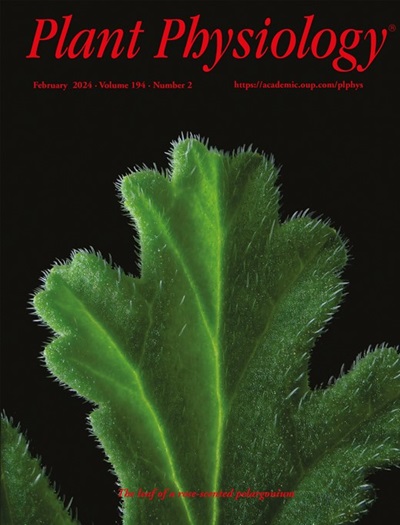The thylakoid- and pyrenoid-localized phosphate transporter PHT4-9 is essential for photosynthesis in Chlamydomonas
IF 6.5
1区 生物学
Q1 PLANT SCIENCES
引用次数: 0
Abstract
Phosphate (Pi) is essential for photosynthesis in the chloroplast of algae and plants. Pi homeostasis in the chloroplast is maintained by transporters from several families, whose identities in algae are largely unknown as compared to land plants. Here, we assess the role of the putative PHOSPHATE TRANSPORTER 4-9 from Chlamydomonas reinhardtii (CrPHT4-9) in maintaining chloroplast Pi homeostasis and modulating photosynthesis. Based on phylogenetic analyses and heterologous expression in a yeast (Saccharomyces cerevisiae) strain lacking Pi transporters, we demonstrate that CrPHT4-9 is a Pi transporter closely related to the chloroplast members of the PHT4 family in Arabidopsis (Arabidopsis thaliana). CrPHT4-9 is localized within the chloroplast, more specifically in the thylakoid membrane network and the tubules traversing the CO2-fixing pyrenoid. Two mutants lacking CrPHT4-9 (Crpht4-9) exhibit defective photoautotrophic growth, altered cell morphology and chloroplast ultrastructure under CO2-limiting conditions. In the Crpht4-9 mutants, we further show an increased proton motive force across the thylakoid membrane, enhanced energy- and state-transition dependent non-photochemical quenching of chlorophyll a fluorescence, and diminished photosynthetic electron transport and ATP synthase activity. The Crpht4-9 mutants exhibit reduced affinity to inorganic carbon, indicating an impaired carbon-concentrating mechanism. These phenotypes are largely recovered by genetic complementation as well as by ample CO2 supply and, interestingly, by Pi deprivation. Therefore, we conclude that the thylakoid- and pyrenoid-localized CrPHT4-9 maintains Pi homeostasis within the chloroplast and is essential for photosynthesis and growth.衣藻的类囊体和类嘌呤转运体PHT4-9对光合作用至关重要
磷酸盐(Pi)是藻类和植物叶绿体光合作用所必需的。叶绿体中的Pi稳态是由来自几个家族的转运体维持的,与陆地植物相比,这些转运体在藻类中的身份在很大程度上是未知的。在这里,我们评估了来自莱茵衣藻(Chlamydomonas reinhardtii)的磷酸盐转运蛋白4-9 (CrPHT4-9)在维持叶绿体Pi稳态和调节光合作用中的作用。基于系统发育分析和在缺乏Pi转运蛋白的酵母(Saccharomyces cerevisiae)中的异源表达,我们证明了CrPHT4-9是与拟南芥(Arabidopsis thaliana)中PHT4家族叶绿体成员密切相关的Pi转运蛋白。CrPHT4-9定位于叶绿体内,更具体地说,定位于类囊体膜网络和穿过固定二氧化碳的类核蛋白的小管。两个缺乏CrPHT4-9的突变体(CrPHT4-9)在co2限制条件下表现出光自养生长缺陷,细胞形态和叶绿体超微结构改变。在Crpht4-9突变体中,我们进一步发现质子动力通过类囊体膜增加,能量和状态转换依赖的叶绿素a荧光非光化学猝灭增强,光合电子传递和ATP合成酶活性降低。Crpht4-9突变体对无机碳的亲和力降低,表明碳浓缩机制受损。这些表型在很大程度上是通过基因互补、充足的二氧化碳供应以及有趣的Pi剥夺来恢复的。因此,我们得出结论,类囊体和类pypyoid定位的CrPHT4-9维持了叶绿体内Pi的稳态,对光合作用和生长至关重要。
本文章由计算机程序翻译,如有差异,请以英文原文为准。
求助全文
约1分钟内获得全文
求助全文
来源期刊

Plant Physiology
生物-植物科学
CiteScore
12.20
自引率
5.40%
发文量
535
审稿时长
2.3 months
期刊介绍:
Plant Physiology® is a distinguished and highly respected journal with a rich history dating back to its establishment in 1926. It stands as a leading international publication in the field of plant biology, covering a comprehensive range of topics from the molecular and structural aspects of plant life to systems biology and ecophysiology. Recognized as the most highly cited journal in plant sciences, Plant Physiology® is a testament to its commitment to excellence and the dissemination of groundbreaking research.
As the official publication of the American Society of Plant Biologists, Plant Physiology® upholds rigorous peer-review standards, ensuring that the scientific community receives the highest quality research. The journal releases 12 issues annually, providing a steady stream of new findings and insights to its readership.
 求助内容:
求助内容: 应助结果提醒方式:
应助结果提醒方式:


